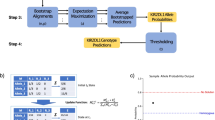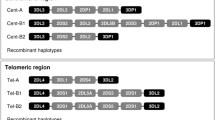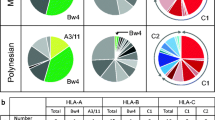Abstract
Killer cell immunoglobulin-like receptors (KIR) are encoded by highly polymorphic genes that regulate the activation of natural killer (NK) cells and other lymphocyte subsets and likely play key roles in innate and adaptive immunity. Association studies increasingly implicate KIR in disease predisposition and outcome but could be confounded by unknown KIR genetic structure in heterogeneous populations. To examine this, we characterized the diversity of 16 KIR genes in 712 Northern Californians (NC) stratified by self-assigned ethnicities and compared the profiles of KIR polymorphism with other US and global populations using a reference database. Sixty-eight distinct KIR genotypes were characterized: 58 in 457 Caucasians (NCC), 17 in 47 African Americans (NCAA), 21 in 80 Asians (NCA), 20 in 74 Hispanics (NCH), and 18 in 54 “other” ethnicities (NCO). KIR genotype patterns and frequencies in the 4 defined ethnicities were compared with each other and with 34 global populations by phylogenetic analysis. Although there were no population-specific genotypes, the KIR genotype frequency patterns faithfully traced the ancestry of NCC, NCAA, and NCA but not of NCH whose ancestries are known to be more heterogeneous. KIR genotype frequencies can therefore track ethnic ancestries in modern urban populations. Our data emphasize the importance of selecting ethnically matched controls in KIR-based studies to avert spurious associations.



Similar content being viewed by others
References
Ashouri E, Farjadian S, Reed EF, Ghaderi A, Rajalingam R (2009) KIR gene content diversity in four Iranian populations. Immunogenetics 61:483–492
Barbujani G, Colonna V (2010) Human genome diversity: frequently asked questions. Trends Genet 26:285–295
Bingham J, Sudarsanam S (2000) Visualizing large hierarchical clusters in hyperbolic space. Bioinformatics 16:660–661
Carrington M, Wang S, Martin MP, Gao X, Schiffman M, Cheng J, Herrero R, Rodriguez AC, Kurman R, Mortel R, Schwartz P, Glass A, Hildesheim A (2005) Hierarchy of resistance to cervical neoplasia mediated by combinations of killer immunoglobulin-like receptor and human leukocyte antigen loci. J Exp Med 201:1069–1075
Cavalli-Sforza LL, Menozzi P, Piazza A (1994) Europe. The history and geography of human genes. Princeton University Press, New Jersey, pp 270–276
Chakraborty BM, Fernandez-Esquer ME, Chakraborty R (1999) Is being Hispanic a risk factor for non-insulin dependent diabetes mellitus (NIDDM)? Ethn Dis 9:278–283
Chewning JH, Gudme CN, Hsu KC, Selvakumar A, Dupont B (2007) KIR2DS1-positive NK cells mediate alloresponse against the C2 HLA-KIR ligand group in vitro. J Immunol 179:854–868
Denis L, Sivula J, Gourraud PA, Kerdudou N, Chout R, Ricard C, Moisan JP, Gagne K, Partanen J, Bignon JD (2005) Genetic diversity of KIR natural killer cell markers in populations from France, Guadeloupe, Finland, Senegal and Reunion. Tissue Antigens 66:267–276
Diner H (2008) Immigrants joining the mainstream. e-Journal USA 13
Djulejic E, Petlichkovski A, Trajkov D, Hristomanova S, Middleton D, Spiroski M (2010) Distribution of killer cell immunoglobulinlike receptors in the Macedonian population. Hum Immunol 71:281–288
Du Z, Gjertson DW, Reed EF, Rajalingam R (2007) Receptor-ligand analyses define minimal killer cell Ig-like receptor (KIR) in humans. Immunogenetics 59:1–15
Ewerton PD, Leite Mde M, Magalhaes M, Sena L, Melo dos Santos EJ (2007) Amazonian Amerindians exhibit high variability of KIR profiles. Immunogenetics 59:625–630
Felsenstein J (1989) PHYLIP—phylogeny inference package (version 3.68). Cladistics, pp. 164–166
Frassati C, Touinssi M, Picard C, Segura M, Galicher V, Papa K, Gagne K, Vivier E, Degioanni A, Boetsch G, Mercier P, Vely F, de Micco P, Reviron D, Chiaroni J (2006) Distribution of killer-cell immunoglobulin-like receptor (KIR) in Comoros and Southeast France. Tissue Antigens 67:356–367
Gendzekhadze K, Norman PJ, Abi-Rached L, Layrisse Z, Parham P (2006) High KIR diversity in Amerindians is maintained using few gene-content haplotypes. Immunogenetics 58:474–480
Gonzalez-Galarza FF, Christmas S, Middleton D, Jones AR (2011) Allele frequency net: a database and online repository for immune gene frequencies in worldwide populations. Nucleic Acids Res 39:D913–D919
Gutierrez-Rodriguez ME, Sandoval-Ramirez L, Diaz-Flores M, Marsh SG, Valladares-Salgado A, Madrigal JA, Mejia-Arangure JM, Garcia CA, Huerta-Zepeda A, Ibarra-Cortes B, Ortega-Camarillo C, Cruz M (2006) KIR gene in ethnic and Mestizo populations from Mexico. Hum Immunol 67:85–93
Halder I, Yang BZ, Kranzler HR, Stein MB, Shriver MD, Gelernter J (2009) Measurement of admixture proportions and description of admixture structure in different U.S. populations. Hum Mutat 30:1299–1309
Hansasuta P, Dong T, Thananchai H, Weekes M, Willberg C, Aldemir H, Rowland-Jones S, Braud VM (2004) Recognition of HLA-A3 and HLA-A11 by KIR3DL2 is peptide-specific. Eur J Immunol 34:1673–1679
Hiby SE, Walker JJ, O’Shaughnessy KM, Redman CW, Carrington M, Trowsdale J, Moffett A (2004) Combinations of maternal KIR and fetal HLA-C genes influence the risk of preeclampsia and reproductive success. J Exp Med 200:957–965
Jiang K, Zhu FM, Lv QF, Yan LX (2005) Distribution of killer cell immunoglobulin-like receptor genes in the Chinese Han population. Tissue Antigens 65:556–563
Jiang B, Hou L, Chen M, Ng J, Hurley CK (2010) The profile of KIR3DL1 and KIR3DS1 alleles in an African American population resembles that found in African populations. Tissue Antigens 76:64–66
Khakoo SI, Thio CL, Martin MP, Brooks CR, Gao X, Astemborski J, Cheng J, Goedert JJ, Vlahov D, Hilgartner M, Cox S, Little AM, Alexander GJ, Cramp ME, O’Brien SJ, Rosenberg WM, Thomas DL, Carrington M (2004) HLA and NK cell inhibitory receptor genes in resolving hepatitis C virus infection. Science 305:872–874
Kulkarni S, Single RM, Martin MP, Rajalingam R, Badwe R, Joshi N, Carrington M (2008) Comparison of the rapidly evolving KIR locus in Parsis and natives of India. Immunogenetics 60:121–129
Lander ES, Schork NJ (1994) Genetic dissection of complex traits. Science 265:2037–2048
Lanier LL (2005) NK cell recognition. Annu Rev Immunol 23:225–274
Lee YC, Chan SH, Ren EC (2008) Asian population frequencies and haplotype distribution of killer cell immunoglobulin-like receptor (KIR) genes among Chinese, Malay, and Indian in Singapore. Immunogenetics 60:645–654
Levinson RD, Du Z, Luo L, Monnet D, Tabary T, Brezin AP, Zhao L, Gjertson DW, Holland GN, Reed EF, Cohen JH, Rajalingam R (2008) Combination of KIR and HLA gene variants augments the risk of developing birdshot chorioretinopathy in HLA-A*29-positive individuals. Genes Immun 9:249–258
Mao X, Bigham AW, Mei R, Gutierrez G, Weiss KM, Brutsaert TD, Leon-Velarde F, Moore LG, Vargas E, McKeigue PM, Shriver MD, Parra EJ (2007) A genomewide admixture mapping panel for Hispanic/Latino populations. Am J Hum Genet 80:1171–1178
Martin MP, Gao X, Lee JH, Nelson GW, Detels R, Goedert JJ, Buchbinder S, Hoots K, Vlahov D, Trowsdale J, Wilson M, O’Brien SJ, Carrington M (2002) Epistatic interaction between KIR3DS1 and HLA-B delays the progression to AIDS. Nat Genet 31:429–434
Martin AM, Kulski JK, Gaudieri S, Witt CS, Freitas EM, Trowsdale J, Christiansen FT (2004) Comparative genomic analysis, diversity and evolution of two KIR haplotypes A and B. Gene 335:121–131
Maxwell LD, Wallace A, Middleton D, Curran MD (2002) A common KIR2DS4 deletion variant in the human that predicts a soluble KIR molecule analogous to the KIR1D molecule observed in the rhesus monkey. Tissue Antigens 60:254–258
Middleton D, Rood H, Komerofsky R (2003) New allele frequency database: http://www.allelefrequencies.net. Tissue Antigens 61(5):403–407
Middleton D, Meenagh A, Gourraud PA (2007) KIR haplotype content at the allele level in 77 Northern Irish families. Immunogenetics 59:145–158
Nelson GW, Martin MP, Gladman D, Wade J, Trowsdale J, Carrington M (2004) Cutting edge: heterozygote advantage in autoimmune disease: hierarchy of protection/susceptibility conferred by HLA and killer Ig-like receptor combinations in psoriatic arthritis. J Immunol 173:4273–4276
Norman PJ, Stephens HA, Verity DH, Chandanayingyong D, Vaughan RW (2001) Distribution of natural killer cell immunoglobulin-like receptor sequences in three ethnic groups. Immunogenetics 52:195–205
Pavlova Y, Kolesar L, Striz I, Jabor A, Slavcev A (2008) Distribution of KIR genes in the Czech population. Int J Immunogenet 35:57–61
Pritchard JK, Donnelly P (2001) Case–control studies of association in structured or admixed populations. Theor Popul Biol 60:227–237
Pult I, Sajantila A, Simanainen J, Georgiev O, Schaffner W, Paabo S (1994) Mitochondrial DNA sequences from Switzerland reveal striking homogeneity of European populations. Biol Chem Hoppe Seyler 375:837–840
Rajalingam R, Krausa P, Shilling HG, Stein JB, Balamurugan A, McGinnis MD, Cheng NW, Mehra NK, Parham P (2002) Distinctive KIR and HLA diversity in a panel of north Indian Hindus. Immunogenetics 53:1009–1019
Rajalingam R, Parham P, Abi-Rached L (2004) Domain shuffling has been the main mechanism forming new hominoid killer cell Ig-like receptors. J Immunol 172:356–369
Risch N, Burchard E, Ziv E, Tang H (2002) Categorization of humans in biomedical research: genes, race and disease. Genome Biol 3(7):comment2007
Rosenberg NA, Pritchard JK, Weber JL, Cann HM, Kidd KK, Zhivotovsky LA, Feldman MW (2002) Genetic structure of human populations. Science 298:2381–2385
Ruggeri L, Capanni M, Urbani E, Perruccio K, Shlomchik WD, Tosti A, Posati S, Rogaia D, Frassoni F, Aversa F, Martelli MF, Velardi A (2002) Effectiveness of donor natural killer cell alloreactivity in mismatched hematopoietic transplants. Science 295:2097–2100
Sajantila A, Lahermo P, Anttinen T, Lukka M, Sistonen P, Savontaus ML, Aula P, Beckman L, Tranebjaerg L, Gedde-Dahl T, Issel-Tarver L, DiRienzo A, Paabo S (1995) Genes and languages in Europe: an analysis of mitochondrial lineages. Genome Res 5:42–52
Sajantila A, Salem AH, Savolainen P, Bauer K, Gierig C, Paabo S (1996) Paternal and maternal DNA lineages reveal a bottleneck in the founding of the Finnish population. Proc Natl Acad Sci USA 93:12035–12039
Salari K, Choudhry S, Tang H, Naqvi M, Lind D, Avila PC, Coyle NE, Ung N, Nazario S, Casal J, Torres-Palacios A, Clark S, Phong A, Gomez I, Matallana H, Perez-Stable EJ, Shriver MD, Kwok PY, Sheppard D, Rodriguez-Cintron W, Risch NJ, Burchard EG, Ziv E (2005) Genetic admixture and asthma-related phenotypes in Mexican American and Puerto Rican asthmatics. Genet Epidemiol 29:76–86
Sans M (2000) Admixture studies in Latin America: from the 20th to the 21st century. Hum Biol 72:155–177
Santin I, de Nanclares GP, Calvo B, Gaafar A, Castano L, Bilbao JR (2006) Killer cell immunoglobulin-like receptor (KIR) genes in the Basque population: association study of KIR gene contents with type 1 diabetes mellitus. Hum Immunol 67:118–124
Shtir CJ, Marjoram P, Azen S, Conti DV, Le Marchand L, Haiman CA, Varma R (2009) Variation in genetic admixture and population structure among Latinos: the Los Angeles Latino Eye Study (LALES). BMC Genet 10:71
Single RM, Martin MP, Gao X, Meyer D, Yeager M, Kidd JR, Kidd KK, Carrington M (2007) Global diversity and evidence for coevolution of KIR and HLA. Nat Genet 39:1114–1119
Single RM, Martin MP, Meyer D, Gao X, Carrington M (2008) Methods for assessing gene content diversity of KIR with examples from a global set of populations. Immunogenetics 60:711–725
Thomas DC, Witte JS (2002) Point: population stratification: a problem for case-control studies of candidate–gene associations? Cancer Epidemiol Biomarkers Prev 11:505–512
Tishkoff SA, Reed FA, Friedlaender FR, Ehret C, Ranciaro A, Froment A, Hirbo JB, Awomoyi AA, Bodo JM, Doumbo O, Ibrahim M, Juma AT, Kotze MJ, Lema G, Moore JH, Mortensen H, Nyambo TB, Omar SA, Powell K, Pretorius GS, Smith MW, Thera MA, Wambebe C, Weber JL, Williams SM (2009) The genetic structure and history of Africans and African Americans. Science 324:1035–1044
Trowsdale J, Parham P (2004) Mini-review: defense strategies and immunity-related genes. Eur J Immunol 34:7–17
Uhrberg M, Valiante NM, Shum BP, Shilling HG, Lienert-Weidenbach K, Corliss B, Tyan D, Lanier LL, Parham P (1997) Human diversity in killer cell inhibitory receptor genes. Immunity 7:753–763
Uhrberg M, Parham P, Wernet P (2002) Definition of gene content for nine common group B haplotypes of the Caucasoid population: KIR haplotypes contain between seven and eleven KIR genes. Immunogenetics 54:221–229
US Census (2010) U.S. Census Bureau. http://2010.census.gov/2010census/
Vilches C, Parham P (2002) KIR: diverse, rapidly evolving receptors of innate and adaptive immunity. Annu Rev Immunol 20:217–251
Vilches C, Castano J, Gomez-Lozano N, Estefania E (2007) Facilitation of KIR genotyping by a PCR-SSP method that amplifies short DNA fragments. Tissue Antigens 70:415–422
Whang DH, Park H, Yoon JA, Park MH (2005) Haplotype analysis of killer cell immunoglobulin-like receptor genes in 77 Korean families. Hum Immunol 66:146–154
Yawata M, Yawata N, McQueen KL, Cheng NW, Guethlein LA, Rajalingam R, Shilling HG, Parham P (2002) Predominance of group A KIR haplotypes in Japanese associated with diverse NK cell repertoires of KIR expression. Immunogenetics 54:543–550
Yawata M, Yawata N, Draghi M, Little AM, Partheniou F, Parham P (2006) Roles for HLA and KIR polymorphisms in natural killer cell repertoire selection and modulation of effector function. J Exp Med 203:633–645
Acknowledgments
We thank the subjects who participated in the study. The work was supported by the National Institutes of Health (NIH) grant R01-DK064051 (to SLC). Drs Cooper and Feng would like to acknowledge NIH Grant P30 DK026743 awarded to the UCSF Liver Center. We also thank the “Ibrahim El Hefni Liver Biorepository” at CPMC, especially Adrian Wadley and Dr. Daniel Stone for providing samples and for valuable input in the manuscript, and Catherine Carr for enthusiastically recruiting patients at CPMC liver clinics. We greatly appreciate the support of the other surgeons and hepatologists who dedicated time for patient recruitment and of the exceptional staff in the Department of Transplantation and Division of Hepatology at CPMC and UCSF and those involved with The UFO Study. Our sincere thanks to Dr. Martin Brotman for facilitating a translational research program at CPMC. We also thank Dr. Marcelo Pando, Ms. Susan Perkin and Dr. Dolly Tyan at Stanford Blood Center for testing duplicate samples. We are grateful to Dr. Jason D. Barbour for critically reading the manuscript and to the reviewers, whose suggestions and comments enriched the scientific content. We also extend our profound gratitude to The Ibrahim El-Hefni Technical Training Foundation and the El-Hefni family, The Kalmanovitz Foundation, The Raab Foundation, Mr. Harry Litke, The Unbroken Chain Foundation, and Mr. and Mrs. John Mumford for supporting multiple aspects of this study; it could not have been accomplished otherwise.
Conflict of interest
The authors declare that they have no conflicts of interest with the organizations that funded the research.
Author information
Authors and Affiliations
Corresponding author
Additional information
The study was conducted in a multi-ethnic cohort from Northern California. Our analysis shows the potential of KIR genotype frequency polymorphism to trace populations to their native ancestries and to foil disease association studies if ethnicity is ignored. The present study focuses on the importance of defining underlying population structure in conducting KIR association studies and highlights KIR genotype polymorphism itself as a useful tool in population structure analysis. The work describes a new dataset and novel analysis. None of the material has been published or is under consideration for publication elsewhere.
Electronic supplementary material
Below is the link to the electronic supplementary material.
Supplementary Figure 1
Phylogenetic tree constructed using KIR genotype frequencies of major ethnicities sampled in Northern California (PDF 95.3 kb)
Supplementary Figure 2
Individual KIR Gene Frequencies in California (PDF 116 kb)
Supplementary Table 1
KIR genotype analysis within California (PDF 122 kb)
Supplementary Table 2
KIR alleles potentially undetected by the typing system (PDF 131 kb)
Rights and permissions
About this article
Cite this article
Singh, K.M., Phung, Y.T., Kohla, M.S. et al. KIR genotypic diversity can track ancestries in heterogeneous populations: a potential confounder for disease association studies. Immunogenetics 64, 97–109 (2012). https://doi.org/10.1007/s00251-011-0569-x
Received:
Accepted:
Published:
Issue Date:
DOI: https://doi.org/10.1007/s00251-011-0569-x




